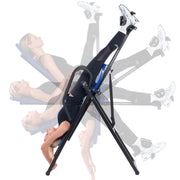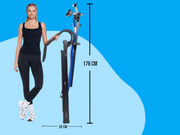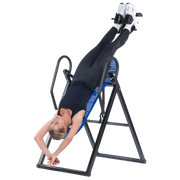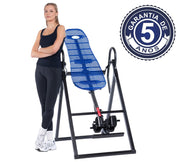Benefits of the inversion table







How to use an inversion table
1. Prepare the Inversion Table
- Place the inversion table on a flat, stable surface.
- Ensure all parts are securely assembled and tightened.
- Adjust the table to match your height:
- Adjust the angle with the Safety Strap to your desired maximum inversion angle (e.g., 20, 40, 60 degrees).
2. Wear Comfortable Clothing
- Wear clothing that allows for free movement.
- Avoid items like belts, jewelry, or anything that may press against your body during inversion.
3. Secure Your Ankles
- Step onto the footrests and place your feet in the ankle supports.
- Tighten the ankle locks snugly but comfortably to ensure your feet are secure.
4. Get Into Position
- Lean back gently and rest against the backrest.
- Use the handlebars for support as you lower yourself into a reclined position.
5. Start at a Mild Angle
- Begin with a slight angle (20-30 degrees) to get used to the feeling of inversion.
- Relax and breathe deeply, allowing your body to adjust.
6. Gradually Increase the Angle
- Over time, as you get comfortable, increase the angle to 60 degrees or more (as recommended).
- Use the arm movements or handlebars to control the tilt smoothly.
7. Limit Your Time
- Start with 1-2 minutes per session, especially if you’re a beginner.
- Gradually work up to 5-10 minutes per session as your body becomes accustomed.
8. Perform Gentle Movements (Optional)
- Once inverted, you can:
9. Return to the Upright Position
- Use the handlebars or your arm movements to slowly return to an upright position.
- Avoid sitting up too quickly; allow your body a few moments to adjust to being upright.
10. Safely Exit the Table
- Unlock the ankle supports and step off the footrests.
- Stand slowly to ensure you don’t feel dizzy or lightheaded.
Important Safety Tips
- Consult your doctor before using an inversion table, especially if you have medical conditions (e.g., high blood pressure, glaucoma, or heart issues).
- Do not use the table if you feel pain, discomfort, or dizziness.
- Always use the inversion table on a stable, flat surface.
- Avoid using the inversion table unsupervised if you’re new to it.
By following these steps, you can safely enjoy the many benefits of inversion therapy. Let me know if you’d like further refinements!

You can easily adjust your maximum angle.
This inversion table is designed to meet your individual needs; it features an adjustable angle strap that allows you to vary the incline angle from 20 to 90 degrees, letting you customize your inversion angle for maximum comfort. It offers full inversion.


Designed to stretch better
- Other brands use foam backing, which can cause rubbing and limit the full stretch potential.
- VelloFit 300 back support is designed to enhance spinal stretching and decompression, providing greater benefits and effective pain relief.
Supports up to 150 kg of weight.
Adjustable height from 147 cm to 198 cm.

Why choose Vellofit 300?
- Premium Construction: Built with a sturdy steel frame and a sleek finish for durability and style.
- Padded Backrest: Ergonomically designed to deliver maximum support and comfort.
- Adjustable Settings: Easily adapts to your height and inversion preferences.
- Safety First: Features a secure ankle locking system for added peace of mind.
- Space-Saving Design: Folds easily for convenient storage.
- 5-Year Warranty: Backed by a reliable, long-term guarantee.

Stretch and alleviate back pain with the customer-favorite VelloFit 300 inversion table, thoughtfully designed for maximum comfort and effective relief.
Frequently Asked Questions
You should start with 1-2 minutes per session and gradually increase the time as you feel comfortable. You can work up to 3-5 minutes, or until your muscles relax.
For best results, you can use the inversion table every day.
You should consult your doctor before using an inversion table if you have certain medical conditions, such as high blood pressure, heart disease, glaucoma, or a history of stroke. You should also consult your doctor if you have arthritis in your knee or hip.
The answer is simple: the angle that feels most comfortable for you. It may take some time for your body to adjust to being upside down and for your muscles to relax while inverted. Listen to your body and only invert to an angle where you can fully relax.
Over time, we recommend gradually working up to a 60-degree angle (parallel to the rear legs of the frame). This is often referred to as the “magic angle” because, at this point, the pressure on your discs is reduced to zero or near zero, allowing for full decompression.



















